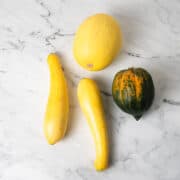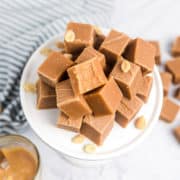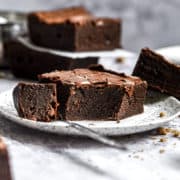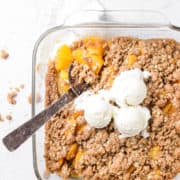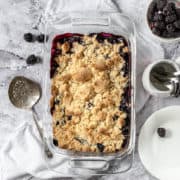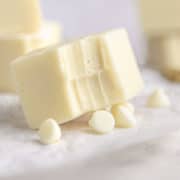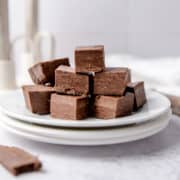Squash is the name given to a variety of different plants including zucchini, butternut squash, and more. Knowing how to store squash means you can always have some on hand for making recipes - summer squash during the summer months and winter squash the rest of the year.

Jump to:
It isn't usually eaten raw although fresh summer squash like zucchini and yellow squash can be. You can eat the skin, flesh, flowers, leaves, and seeds of squash, and use it in a wide variety of recipes.
I love cutting zucchini and yellow squash into matchstick shapes and sauteing them in olive oil and a little garlic as a side dish. As for winter squashes, how can you go wrong with homemade butternut squash soup, or ground beef stuffed acorn squash?
Pumpkin is another kind of squash but a sweet one, which is why it's often used in desserts like pumpkin brownies, pumpkin pie bars, and healthy pumpkin bars, as well as in savory dishes.
I love adding leftover roasted pumpkin to salads in the summer. The sweet flavor and crispy exterior complement literally any salad you're making!
What is Squash?
Squash is a fruit, botanically speaking, since it develops from a plant's flowers and has seeds if grown in ideal conditions. Flowers known as "squash blossoms" grow out of squash.
Squash comes in different varieties. Winter squash varieties which appear from early fall until late spring include acorn, Delicata, spaghetti squash, Hubbard, pumpkin, and butternut squash. Summer varieties which appear from June until September include yellow squash and zucchini.
Squash is ready for harvest once fully matured, which is around 80 to 110 days for winter squash or 60 days for summer squash. Most squash are colorful like fruit but with a savory or neutral flavor like vegetables. Pumpkin and butternut squash are high in natural sugars, hence their sweeter flavor.
Winter squash can be boiled, steamed, or roasted, and is great with olive oil or butter and herbs. It's nice in soups and also in salads. You can also stuff them.
Summer squash are good grilled, sauteed, or roasted. They can be spiralized to make a low-carb or keto version of noodles, or added to muffins and sweet breads.
Every kind of squash is healthy. Summer squash is rich in Vitamins B and C, while winter squash usually contains Vitamin A, fiber, and potassium. So you can indulge in this delicious vegetable (well, technically fruit) whenever you want something that's both tasty and flavorful.
How to Choose the Best Squash
Regardless of the type of squash type you want to buy, there are some handy tips that apply to them all. Look for squash that's a uniform color all over and which is firm in texture rather than squishy. Fresh squash should feel heavy for its size and be free from soft spots and blemishes.
Winter varieties are considered to be mature fruit when you can't scratch the skin of the squash with a fingernail, but if it's shiny and bright and you can scratch a mark, it's unripe.
Summer squash is considered mature when the skin is glossy and you can make a mark with a fingernail. If you can't then it's way beyond its prime.
The stem should be dry, matte (not shiny), and a beige color. Don't buy squash that has very rough, hard skin because this can indicate a nutrient deficiency or pest damage while it was growing.
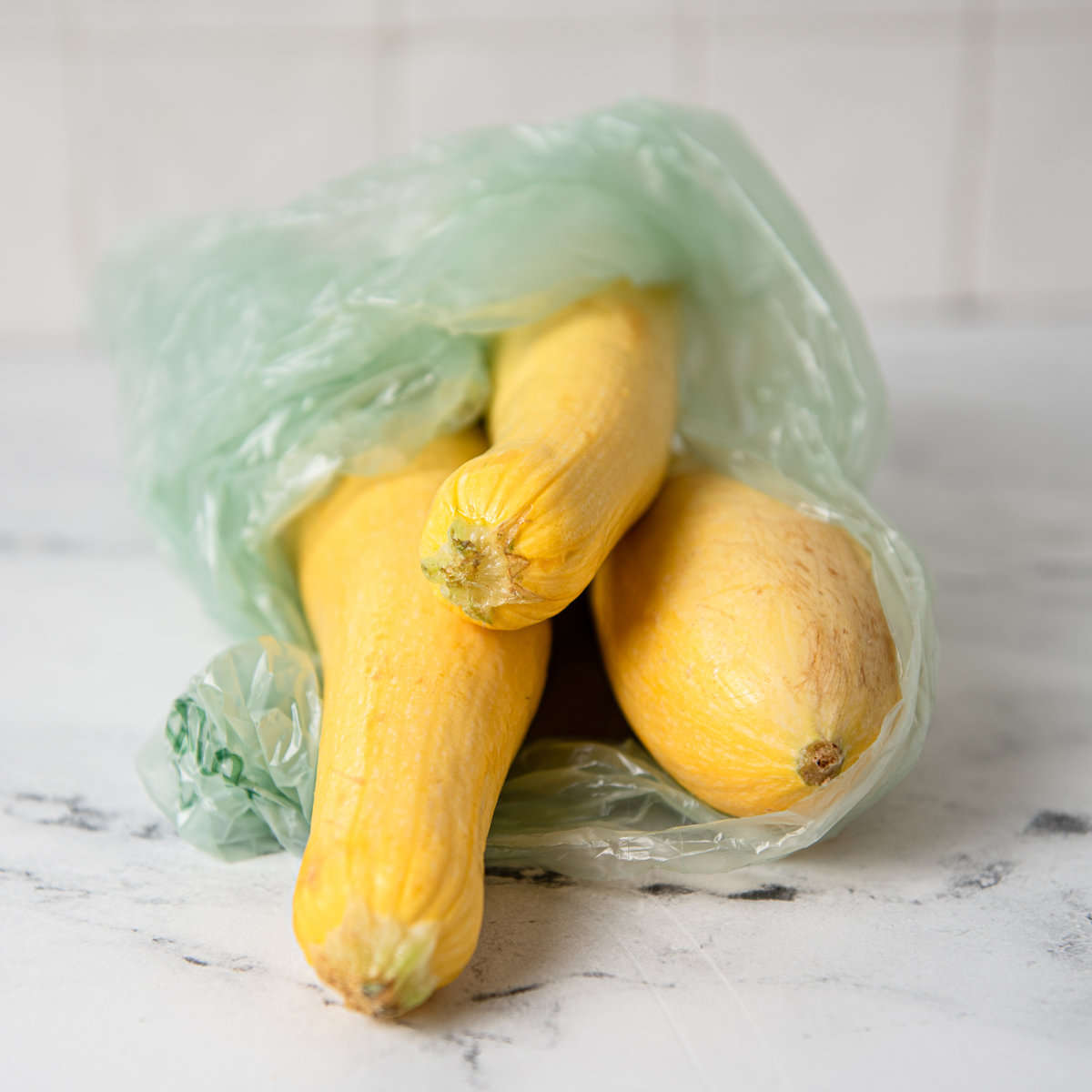
How to Store Squash
Different types of squash need different storage conditions, but you can break the varieties down into summer and winter varieties since each kind has different storage requirements.
Storing Winter Squash:
- For long-term storage, you need to "cure" winter squash, which means letting it sit somewhere warm for 2 weeks with good ventilation.
- The winter squash curing process works best with an ideal temperature between 80°F and 85°F and with a humidity level of 80-85%.
- If you can't cure it outside, put it in a warm garage or shed with a fan to keep the air moving, and keep it out of direct sunlight. After this, you can transfer it somewhere else, such as a root cellar or similar place, to extend its shelf life.
- A good rule of thumb is that the lower the temperature, the longer winter squash will keep, so pick a dark place that's between 50 and 55°F with good air circulation to maintain the relative humidity (50 to 70% is best) and temperature and help prevent rot.
- Blue Hubbard squash can last for 5 months, butternut squash maybe 2 or 3 months, and acorn squash has a storage time of up to 6 weeks.
Storing Summer Squash:
- It's best to inspect summer squash in storage every week, if it's in there a long time, to check for signs of spoilage.
- The best way to prepare summer squash is to wipe it clean with a moist cloth and wipe off the excess moisture.
- Put it in a perforated plastic bag to protect it but allow air to circulate.
- A great place to keep it is in the crisper drawer of your refrigerator for up to 4 days.
- For the best results, don't keep squash near bananas, pears, apples, or any other ripening fruit which releases ethylene gas and will shorten the storage life of the squash.
- After 4 days, refrigerated summer squash will suffer from chilling injuries such as yellowing, loss of water, pitting on the surface, and decay.
- You can freeze summer squash if you peel, cube, and blanch it in boiling water for a few minutes. Flash freeze in a single layer on a baking sheet then transfer into freezer bags or airtight containers.
You don't have to thaw it. You can just add the frozen squash cubes directly to your soup or stew and it will thaw and cook in a few minutes.
Alternatively, it will thaw at room temperature within an hour or so.
How to Tell if Squash is Spoiled
Rotten squash might have damaged parts or discoloration in areas, perhaps brown patches. A bad smell is another indicator of spoilage, as is visible mold or a soft, squishy patch.
A good squash should have dense, firm flesh, while a rotten one is more likely to have watery or mushy flesh.
Common Questions
This type of squash doesn't have a taste like spaghetti, but it's so named because when cooked, the flesh separates into spaghetti-like noodle shapes. It's not as sweet as most other winter squashes and makes a nice reduced-carb option in place of wheat spaghetti. I like to mix the separated strands with tomato sauce, garlic puree, and dried oregano, top with mozzarella and parmesan cheese, and give it a few minutes under the broiler, for a simple Italian-inspired side dish.
This depends on the type of squash. Summer squash tends to have thin skin, as do some winter varieties like Delicata. Most other winter squash has skin that's too tough and hard to eat and should be removed.

Unusual Facts
- Squash is a very old crop that dates back more than 10,000 years when they were cultivated in Mexico and was enjoyed along with other staples like beans and corn.
- The United States imports more than 300,000 tons of squash annually, which is more than any other country.
Winter squashes are actually harvested in the late summer or fall rather than the winter, but they have their name because you can store winter squash for months, for winter use.
